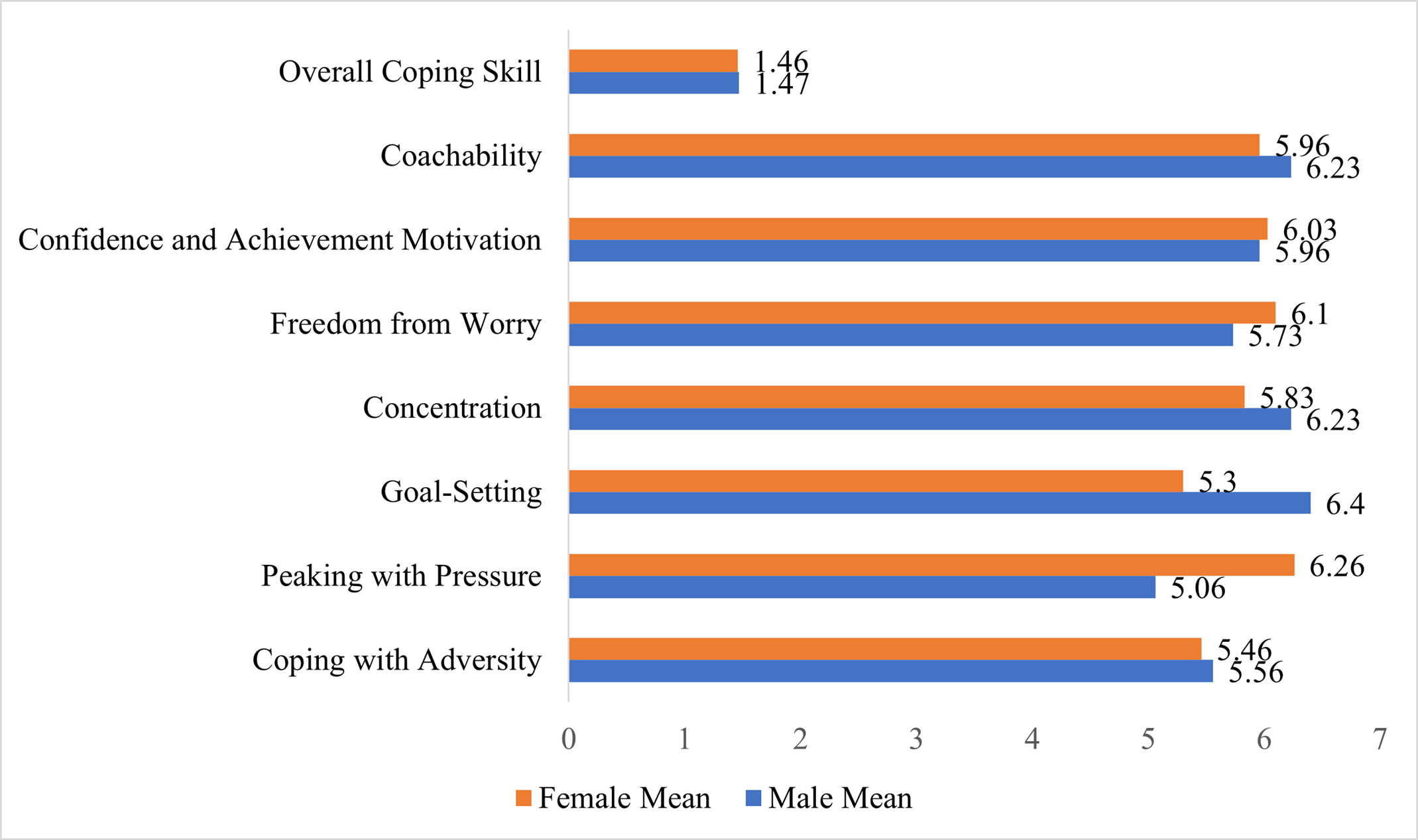Gender Based Disparities in Anxiety Experienced by Athletes and their Coping Mechanisms
DOI:
https://doi.org/10.60081/SSHA.3.1.2025.359-367Keywords:
Sports Anxiety, Coping Skills, Gender Differences, Competitive Athletes, Psychological ResilienceAbstract
Purpose: The purpose of this study was to examine the anxiety levels experienced by male and female athletes and their coping skills in managing anxiety. The research aimed to address gaps in understanding how psychological traits, beyond biological sex, influence athletes' anxiety and coping strategies. Additionally, the study focused on age- and sport-specific differences by concentrating on younger athletes participating in handball, volleyball, and basketball. Method: Data were collected from 60 athletes (30 males and 30 females) aged 12-16 years, representing handball, volleyball, and basketball. The Athletic Coping Skill Inventory-28 and the Sports Anxiety Scale-2 questionnaires were used to assess coping skills and anxiety levels, respectively. Statistical analyses, including descriptive statistics, independent sample t-tests, and Pearson correlation, were conducted using IBM SPSS-27. Results: The results showed no statistically significant gender differences in total anxiety (p = 0.106), the three sub-domains of anxiety-somatic anxiety (p = 0.158), worry (p = 0.886), concentration disruption (p = 0.136)-or coping skills (p = 0.903). However, female athletes exhibited slightly higher anxiety levels than males. Pearson correlation analysis revealed a weak negative relationship between sports anxiety and coping skills for both genders, but these correlations were not statistically significant for males (r = -0.113, p = 0.551) or females (r = -0.227, p = 0.228). Conclusions: The study concludes that individual psychological traits and training experiences may play a more significant role in shaping anxiety and coping responses than gender alone. The authors recommend future research with larger and more diverse samples to further clarify these relationships and inform targeted psychological interventions for athletes.
References
Correia, M., & Rosado, A. (2019). Anxiety in athletes: Gender and type of sport differences. International Journal of Psychological Research, 12(1), 9–17. https://doi.org/10.21500/20112084.3552
Cosma, G., Chiracu, A., Stepan, R., Cosma, A., Nanu, C., & Păunescu, C. (2020). Impact of coping strategies on sport performance. Journal of Physical Education and Sport, 20(3), 1380–1385. https://doi.org/10.5267/j.dsl.2020.3.003
Crocher, P. R., Kowalski, K. C., & Graham, T. R. (1998). Measurement of coping strategies in sport (pp. 149–161).
Dean, E. (2016). Anxiety. Nursing Standard, 30(46), 15–15. https://doi.org/10.7748/ns.30.46.15.s17
Ford, J. L., Ildefonso, K., Jones, M. L., Arvinen-barrow, M., Ford, J. L., Ildefonso, K., Jones, M. L., Arvinen-barrow, M., & Arvinen-barrow, M. (2017). Sport-related anxiety : current insights. Open Access Journal of Sports Medicine, 205–212. https://doi.org/10.2147/OAJSMS125845
Hardy, L., & Parfitt, G. (1991). A catastrophe model of anxiety and performance. British Journal of Psychology, 82(2), 163–178. https://doi.org/10.1111/j.2044-8295.1991.tb02391.x
Ivaskevych, D., Borysova, O., Fedorchuk, S., Tukaiev, S., Kohut, I., Marynych, V., Petrushevskyi, Y., Ivaskevych, O., & Mihăila, I. (2019). Gender differences in competitive anxiety and coping strategies within junior handball national team. Journal of Physical Education and Sport, 19(2), 1242–1246. https://doi.org/10.7752/jpes.2019.02180
Kushwaha, L., & Tyagi, D. S. (2023). Comparative study on sports anxiety irrespective of gender differences among badminton and tennis players. Journal of Sports Science and Nutrition, 4(1), 162–164. https://doi.org/10.33545/27077012.2023.v4.i1c.165
Lazarus, R. S. (1984). STRESS, APPRAISAL, AND COPING.
Lazarus, R. S. (2000). How Emotions Influence Performance in Competitive Sports. The Sport Psychologist, 14(3), 229–252. https://doi.org/10.1123/tsp.14.3.229
Martens, R., Vealey, R. S., & Burton, D. (1990). COMPETITIVE ANXIETY IN SPORTS (C. Drews; (ed.)). Human Kinetics Books.
Mellalieu, S. D., Hanton, S., & Fletcher, D. (2015). Contemporary advances in sport psychology: A review. In Contemporary Advances in Sport Psychology: A Review (Issue January 2015). https://doi.org/10.4324/9781315813059
Mohamed Ali, B. (2013). Effect of gender and type of sport practiced on aggression and self-esteem in Tunisian athletes. IOSR Journal of Humanities and Social Science, 8(4), 74–80. https://doi.org/10.9790/0837-0847480
Mukherjee, A. (2023). Anxiety in Volleyball: Gender Differences During Competition. Indian Journal of YOGA Exercise & Sport Science and Physical Education, 25–32. https://doi.org/10.58914/ijyesspe.2023-8.2.5
Nicholls, A. R., Levy, A. R., & Perry, J. L. (2015). Emotional maturity, dispositional coping, and coping effectiveness among adolescent athletes. Psychology of Sport and Exercise, 17, 32–39. https://doi.org/10.1016/j.psychsport.2014.11.004
Ntoumanis, N., & Biddle, S. J. H. (2000). Relationship of Intensity and Direction of Competitive Anxiety with Coping Strategies. The Sport Psychologist, 14(4), 360–371. https://doi.org/10.1123/tsp.14.4.360
Okros, C., Konig-Gorogh, D., & Gyomber, N. (2020). Coping Strategies of Elite Hungarian Junior Handball Players. Acta Medicinae et Sociologica, 11(30), 5–15. https://doi.org/10.19055/ams.2020.11/30/1
Roth, S., & Cohen, L. J. (1986). Approach , Avoidance , and Coping With Stress. Americal Psychologist, 813–819.
Smith, R. E., Schutz, R. W., Smoll, F. L., & Ptacek, J. T. (2016). Development and Validation of a Multidimensional Measure of Sport-Specific Psychological Skills: The Athletic Coping Skills Inventory-28. Journal of Sport and Exercise Psychology, 17(4), 379–398. https://doi.org/10.1123/jsep.17.4.379
Smith, R. E., & Smoll, F. L. (1990). Sport Performance Anxiety. Handbook of Social and Evaluation Anxiety, 417–454. https://doi.org/10.1007/978-1-4899-2504-6_14
Smith, R. E., Smoll, F. L., Cumming, S. P., & Grossbard, J. R. (2006). Measurement of Multidimensional Sport Performance Anxiety in Children and Adults : The Sport Anxiety Scale-2. Journal of Sport & Exercise Psychology, 479–501.
WEINBERG, R. S., & GOULD, D. (2023). Foundations of Sport and Exercise Psychology. Journal of Sport and Exercise Psychology, 20(3), 336–338. https://doi.org/10.1123/jsep.20.3.336

Downloads
Published
Issue
Section
License
Copyright (c) 2025 Manish Acharjee, Prabal Dutta, Rahul Devchoudhury

This work is licensed under a Creative Commons Attribution 4.0 International License.







